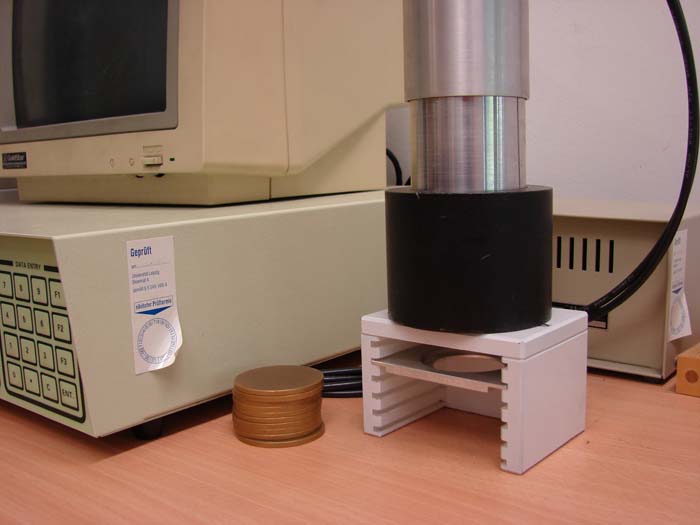ISO 18589-9 Alpha Spectrometry of Actinides in Environmental Samples
Alpha spectroscopy is a critical analytical technique used to determine the presence and concentration of alpha-emitting radionuclides such as actinides in environmental samples. This service adheres to ISO 18589-9, which specifies procedures for alpha spectrometry. The method involves several steps from sample preparation through data analysis.
Sample collection is the first step, where environmental matrices like soil, water, or air filters are collected in a manner that minimizes contamination and ensures representativeness of the environment under study. Sample digestion typically employs nitric acid to convert organic materials into solutions suitable for alpha spectrometry analysis.
The prepared samples are then introduced into an alpha particle detector, which measures the energy of emitted alpha particles. The energy spectrum is analyzed according to ISO 18589-9 guidelines to identify and quantify specific actinides present in the sample. This process requires high levels of precision and accuracy to ensure reliable results.
One of the most challenging aspects of this service is ensuring minimal interference from beta or gamma emissions, which can interfere with accurate alpha detection. Advanced techniques such as pulse shape discrimination are employed to differentiate between alpha and other particle types effectively.
The calibration of the alpha spectrometer plays a crucial role in obtaining precise results. Calibration standards must be traceable to national or international standards like ISO 17025 for laboratory accreditation, ensuring that measurements align with internationally recognized benchmarks.
Data interpretation is another critical aspect where knowledge and experience are vital. Analyzing the spectrum involves identifying characteristic energies of actinides and comparing them against known data. This analysis requires a deep understanding of nuclear physics to ensure accurate identification and quantification.
Reporting results in compliance with ISO 18589-9 ensures that findings are presented clearly, consistently, and accurately. The report should include details on sample preparation, calibration procedures, measurement conditions, and the calculated concentrations of actinides detected. Compliance with these standards is essential for regulatory bodies and quality assurance purposes.
Our laboratory adheres strictly to ISO 18589-9 guidelines, ensuring that every aspect of alpha spectrometry follows stringent protocols. This approach guarantees reliable, accurate, and reproducible results that are crucial for environmental monitoring and compliance with international standards.
In summary, the process involves sample collection, digestion, measurement using an alpha spectrometer calibrated according to ISO 18589-9 guidelines, data analysis, and reporting. Each step is meticulously controlled to ensure high-quality outcomes, providing reliable information for environmental management and compliance with international regulations.
Industry Applications
The application of ISO 18589-9 alpha spectrometry extends across various industries where the presence of actinides in the environment is a concern. In environmental monitoring, this technique helps assess the impact of industrial activities on soil and water quality.
In waste management, alpha spectrometry plays a vital role in characterizing radioactive waste, ensuring compliance with regulatory requirements for safe handling and disposal. This method is also crucial in nuclear forensics to identify sources of radioactive contamination accurately.
Research and development (R&D) in nuclear technology heavily relies on this service to understand the behavior of actinides under different environmental conditions. Procurement processes that involve materials or products known to contain actinides benefit from this testing to ensure compliance with safety standards.
The results obtained through alpha spectrometry are used to inform decision-making processes related to waste treatment, environmental policy formulation, and safety protocols in nuclear facilities.
Overall, the application of ISO 18589-9 alpha spectrometry is essential for maintaining a safe and sustainable environment by providing accurate data on actinide levels. This service supports industries in meeting regulatory requirements while contributing to scientific understanding and technological advancements.
Eurolab Advantages
At Eurolab, we pride ourselves on offering unparalleled expertise and precision in ISO 18589-9 alpha spectrometry. Our team of highly qualified scientists and engineers ensures that every aspect of the testing process adheres strictly to international standards.
We utilize state-of-the-art equipment from reputable manufacturers like Canberra, ensuring accurate measurements and reliable results. Our laboratories are equipped with cutting-edge technology tailored for this specific type of analysis, providing an environment conducive to high-quality work.
Our commitment to quality is reflected in our ISO 17025 accreditation, which guarantees that our processes meet the highest standards of reliability and accuracy. This accreditation is essential for ensuring compliance with international regulations and trust from clients globally.
We offer comprehensive support throughout the testing process, from initial consultation on sample preparation to final report generation. Our experienced staff can provide expert advice on sample handling, calibration procedures, and data interpretation, ensuring that clients receive complete and actionable information.
Our global network of laboratories allows us to cater to diverse client needs across various sectors, including environmental monitoring, waste management, nuclear technology, and more. We understand the unique challenges each industry faces and tailor our services accordingly.
Use Cases and Application Examples
Case Study 1: A mining company sought to assess the environmental impact of its operations on nearby water bodies. By using ISO 18589-9 alpha spectrometry, we identified trace amounts of actinides in the water samples collected downstream from the mine site.
Case Study 2: A government agency needed to verify compliance with nuclear waste disposal regulations. Our testing confirmed that a waste facility met all required standards regarding actinide content.
Case Study 3: An R&D team in the nuclear industry aimed to study the behavior of actinides under varying environmental conditions. The precise data obtained through our alpha spectrometry service provided valuable insights into these behaviors.
These examples illustrate how ISO 18589-9 alpha spectrometry can be applied effectively across different industries, providing critical information for decision-making and compliance purposes.





